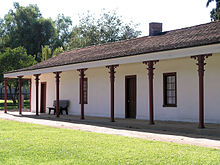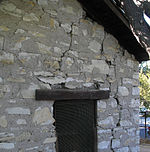Rancho Los Encinos
Rancho El Encino | |
Basque vernacular | |
| NRHP reference No. | 71000142 [1] |
|---|---|
| Added to NRHP | February 24, 1971 |
Rancho Los Encinos (also Rancho El Encino and Rancho Encino) was a Spanish grazing concession,
History
Origins
The name of the rancho derives from the original designation of the Valley by the
The naturally carbonated

Reyes was accused of mistreating the
In 1849, Don
With the
to Vicente de la Osa et al Jan. 8, 1873, for 4,460.73 acres.Boom and bust
The
The De La Osa rancho was a popular stopping point for

With the cattle market in collapse and besieged by mounting debts, in 1859 De la Osa converted his house into a roadside inn and began to charge patrons for his legendary
The property changed hands three times in the next twenty years, having been acquired by Simon Gless a Basque who was married to a French woman and four other native women; eventually, he sold the property to his Basque father-in-law, Domingo Amestoy, <Gless family archives>in 1889. The fields were used for wheat farming, as was most of the Valley after Isaac Newton Van Nuys introduced dryland farming there. The Amestoy family lived on the property until 1945, selling off 1,170 acres (5 km2) of land in 1916 that would become the community of Encino, and further subdividing the ranchlands thereafter.
In a story typical of the San Fernando Valley's rapid urbanization, the adobe was used as the sales office for the post-war subdivisions surrounding it—and was to be torn down and used as commercial property. Concerned neighbors led a fight to have the adobe, and the spring, to be purchased by the State of California.
The last remaining parcel, including the historic buildings and the
Los Encinos State Historic Park


All of the historic buildings in the park were heavily damaged in the 1994 Northridge earthquake. The De la Osa adobe and the stone Garnier building have been repaired and restored, with the Garnier building now serving as a visitor center with historic photographs and exhibits of the rancho's past.[18] The Los Encinos Photos archives are also online.[18] The 1902 river stones and mortar walled, double-roofed, food-cool storage buildings built for the Amestoys still show signs of the earthquake and are used for Park storage.
A major
In 2011, the State of California threatened to close the park, because the park makes no revenue to equalize the employees needed. Through community effort and the Encino Neighborhood Council, an anonymous donor was found who volunteered $150,000 (pending as of 1/12) to keep the park open.
The park is located at 16756 Moorpark Street, Encino, California, 91436-1068, and is open to the public 10 AM to 5 PM, Wednesday through Sunday. There is a pedestrian entrance on Ventura Boulevard.
Map gallery
-
Plat map of Rancho Los Encinos, based on an 1868 survey and registered for Eugene Garnier in 1873.
-
1880 manuscript map of the southeastern San Fernando Valley, with Rancho Los Encinos at the lower left and the Los Angeles River running southeast through the property.
-
The Butterfield Overland Mail stagecoach route highlighted from Rancho Los Encinos (bottom) to the Santa Susana Pass (upper left), on 1880 manuscript map of the western San Fernando Valley.
See also
- Ranchos of California
- List of Ranchos of California
- History of the San Fernando Valley to 1915
- List of Los Angeles Historic-Cultural Monuments in the San Fernando Valley
- National Register of Historic Places listings in Los Angeles, California
- National Register of Historic Places listings in Los Angeles County, California
- History of Los Angeles, California
Notes
- ^ "National Register Information System". National Register of Historic Places. National Park Service. January 23, 2007.
- ^ Beck, Warren A. and Ynez D. Haase, Historical Atlas of California, p. 37
- ^ Bearchell, Charles, and Larry D. Fried: The San Fernando Valley Then and Now, p. 93
- ^ Bearchell and Fried, p. 28, 68-69, 93-95
- ^ "Los Encinos State Historic Park History". los-encinos.org. Retrieved November 12, 2023.
- ^ a b Bearchell and Fried, p. 94-96
- ^ Kielbasa, Historic Adobes of Los Angeles County, p. 34.
- ^ a b Archives, L. A. Times (January 18, 1998). "Back to the Rancho". Los Angeles Times. Retrieved November 12, 2023.
- ^ United States. District Court (California : Southern District) Land Case 392 SD
- ^ Finding Aid to the Documents Pertaining to the Adjudication of Private Land Claims in California, circa 1852-1892
- ^ Cleland, Robert Glass: The Cattle on a Thousand Hills: Southern California, 1850-1870
- ^ Link, Tom: Universal City – North Hollywood, a Centenniel Portrait, p. 25
- ^ The stagecoach routes can clearly be seen on period maps; see the Map Gallery.
- ^ Bevill, Arthur D. (2007). Santa Susana Pass State Historic Park Cultural Resource Survey Historic Overview (PDF). Archived from the original (PDF) on October 27, 2008.
- ^ Old Stagecoach Trail at www.trails.com
- ^ a b Kielbasa, p. 35
- ^ a picture of the Garnier house in southern France can be seen in the Visitor Center
- ^ a b "Historic Parks of Southern California". Archived from the original on October 1, 2003. Retrieved August 16, 2023.
- ^ laokay: History of Rancho Los Encinos accessed 8/20/2010
External links
- Los Encinos State Historic Park: History Resource Center website
- History of Rancho Los Encinos
- National Park Service—NRHP Travel Itinerary: Rancho El Encino
- Map of old Spanish and Mexican ranchos in Los Angeles County
References
- Bearchell, Charles, and Larry D. Fried: The San Fernando Valley Then and Now, Windsor Publications, 1988, ISBN 0897812859
- Beck, Warren A. and Ynez D. Haase, Historical Atlas of California, University of Oklahoma Press, 1974 (first edition), ISBN 0-8061-1212-3
- Cleland, Robert Glass: The Cattle on a Thousand Hills: Southern California, 1850-1880, Huntington Library, 1941; University of California Press, ISBN 978-0-87328-097-6; online at [1].
- Kielbasa, John R. (1998). "Rancho Los Encinos". Historic Adobes of Los Angeles County. ISBN 0-8059-4172-X..
- Link, Tom: Universal City – North Hollywood, a Centenniel Portrait, Windsor Publications, 1991, ISBN 0-89781-393-6
- Roderick, Kevin: The San Fernando Valley: America's Suburb, Los Angeles Times Books, 2001, ISBN 1-883792-55-X




